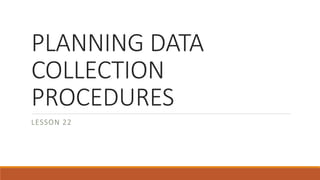Lesson 22 planning data collection procedures
•Download as PPTX, PDF•
5 likes•8,805 views
PRACTICAL RESEARCH 2 POWERPOINT
Report
Share
Report
Share

Recommended
More Related Content
What's hot
What's hot (20)
Lesson 4 Characteristics, Strengths, and Weaknesses of Qualitative Research.pptx

Lesson 4 Characteristics, Strengths, and Weaknesses of Qualitative Research.pptx
3. learning from other and reviewing the literature

3. learning from other and reviewing the literature
Lesson 16 illustrating and explaining conceptual framewok

Lesson 16 illustrating and explaining conceptual framewok
Understanding data and ways on systematically collecting data

Understanding data and ways on systematically collecting data
Similar to Lesson 22 planning data collection procedures
Similar to Lesson 22 planning data collection procedures (20)
Chapter 9 Data Collection Observation Interviews and Tests

Chapter 9 Data Collection Observation Interviews and Tests
chapter4-understandingdataandwaystosystematicallycollectdata-170809052400.pptx

chapter4-understandingdataandwaystosystematicallycollectdata-170809052400.pptx
More from mjlobetos
More from mjlobetos (20)
Lesson 28 drawing logical conclusions from research findings

Lesson 28 drawing logical conclusions from research findings
Lesson 27 using statistical techniques in analyzing data

Lesson 27 using statistical techniques in analyzing data
Lesson 26 presenting and interpreting data in tabular and graphical froms

Lesson 26 presenting and interpreting data in tabular and graphical froms
Lesson 21 designing the questionaire and establishing validity and reliabilty

Lesson 21 designing the questionaire and establishing validity and reliabilty
Lesson 20 describing sample size and sampling procedures

Lesson 20 describing sample size and sampling procedures
Lesson 15 following ethical standards in writing literature

Lesson 15 following ethical standards in writing literature
Lesson 13 synthesizing information from relavant literature

Lesson 13 synthesizing information from relavant literature
Lesson 12 citing related literature using standard styles

Lesson 12 citing related literature using standard styles
Lesson 9 citing benefits and beneficiaries of research study

Lesson 9 citing benefits and beneficiaries of research study
Recently uploaded
Model Call Girl in Bikash Puri Delhi reach out to us at 🔝9953056974🔝

Model Call Girl in Bikash Puri Delhi reach out to us at 🔝9953056974🔝9953056974 Low Rate Call Girls In Saket, Delhi NCR
Organic Name Reactions for the students and aspirants of Chemistry12th.pptx

Organic Name Reactions for the students and aspirants of Chemistry12th.pptxVS Mahajan Coaching Centre
Recently uploaded (20)
ENGLISH5 QUARTER4 MODULE1 WEEK1-3 How Visual and Multimedia Elements.pptx

ENGLISH5 QUARTER4 MODULE1 WEEK1-3 How Visual and Multimedia Elements.pptx
Incoming and Outgoing Shipments in 1 STEP Using Odoo 17

Incoming and Outgoing Shipments in 1 STEP Using Odoo 17
18-04-UA_REPORT_MEDIALITERAСY_INDEX-DM_23-1-final-eng.pdf

18-04-UA_REPORT_MEDIALITERAСY_INDEX-DM_23-1-final-eng.pdf
Introduction to ArtificiaI Intelligence in Higher Education

Introduction to ArtificiaI Intelligence in Higher Education
internship ppt on smartinternz platform as salesforce developer

internship ppt on smartinternz platform as salesforce developer
Hybridoma Technology ( Production , Purification , and Application ) 

Hybridoma Technology ( Production , Purification , and Application )
Enzyme, Pharmaceutical Aids, Miscellaneous Last Part of Chapter no 5th.pdf

Enzyme, Pharmaceutical Aids, Miscellaneous Last Part of Chapter no 5th.pdf
Model Call Girl in Bikash Puri Delhi reach out to us at 🔝9953056974🔝

Model Call Girl in Bikash Puri Delhi reach out to us at 🔝9953056974🔝
Organic Name Reactions for the students and aspirants of Chemistry12th.pptx

Organic Name Reactions for the students and aspirants of Chemistry12th.pptx
Presiding Officer Training module 2024 lok sabha elections

Presiding Officer Training module 2024 lok sabha elections
Lesson 22 planning data collection procedures
- 2. INTRODUCTION Data collection refers to the process of gathering information. The data that you will collect should be able to answer the questions you posed in your Statement of the Problem.
- 3. Types of Quantitative Data Collection Procedures A. Observation ◦ This method of gathering is usually used in situations where the respondents cannot answer the researcher’s question to obtain information for a research study. ◦ The observation is structured to elicit information that could be coded to give numerical data. ◦ As a researcher, you have to prepare a checklist using an appropriate rating scales that may categorize the behavior, attitude or attribute that you are observing to answer the questions posed in your study.
- 4. Types of Quantitative Data Collection Procedures B. Survey The researcher collects data from a sample of population to estimate the attributes or characteristics of the population. Example: survey of customer satisfaction, health care, politics
- 5. Types of Quantitative Data Collection Procedures C. Quantitative Interview ◦ In conducting quantitative interview, the researcher prepares an interview guide or schedule. It contains the list of questions and answer options that the researcher will read to the respondent. ◦ The interview guide may contain closed-ended questions and a few open-ended questions as well, that are delivered in the same format and same order to every respondent. ◦ This method of collecting data involves gathering of information from a large representative sample, which is quite laborious.
- 6. Types of Quantitative Data Collection Procedures D. Questionnaire ◦A questionnaire may be standardized or researcher-made. ◦A standardized questionnaire has gone through the process of psychometric validation, has been piloted and revised.
- 7. Things to be discussed in using researcher made questionnaire. 1. The corrections and suggestions made on the draft to improve the instrument. 2. The different persons involved in the correction and refinement of the research instrument. 3. the pre-testing efforts and subsequent instrument revisions. 4. the type of items used in the instrument. 5. the reliability of the data and evidence of validity. 6. the steps involved in scoring, guidelines for interpretation.
- 8. Guides in making a researcher made questionnaire. 1. Avoid leading questions. 2. Be specific with what you like to measure. 3. Avoid unfamiliar words that the respondents might not be familiar with. 4. Multiple choice categories should be mutually exclusive to elicit clear choices. 5. Avoid personal questions, which may intrude into the privacy of the respondents like questions pertaining to income, family life, beliefs, political affiliation. 6. Make your questions short and easy to answer.